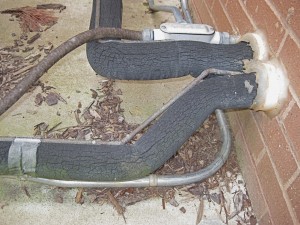“What’s wrong with using Rubatex to insulate solar thermal system piping?”

Deteriorating Rubber Insulation
You may have heard me say before not to use any type of rubber when insulating the pipes of solar hot water systems. The picture to the right shows why. This rubber insulation was installed on a new A/C unit only some 4 years ago. The unit is in the shadow of a building and is as protected from the weather as any outside unit can be. There are no extreme temperatures involved here.
Many commercial and residential solar installers use Armaflex and Rubatex foam insulation on solar thermal systems. There are several grades, including one for outdoor use. This material typically won’t last long on a solar water heating system out in the sun with high pipe temperatures. Some contractors have used latex paint to protect the rubber surface. As far as I’ve seen, that may add a year to the life of the rubber. Eventually it will deteriorate and need replacing.
The best way to protect the external piping of a solar hot water system is to use an aluminum jacketing over either fiberglass or iso foam insulation. The jacket must be carefully installed to prevent moisture penetration. This is done by “shingling” or lapping the joints downhill. Seams should be on the bottom. As an added layer of protection, I always recommend caulking the seams and joints.
The butt joint between the aluminum jacket and the collectors – and the small lines between collectors – are the hardest to seal. A big bead of silicone caulk at the joint is required. This spot is the most prone to shrinking and pulling apart, so it should be checked periodically.
Doing things right the first time may take a little more time and cost a little more money. But installing a solar thermal system that will pass the tests of time and exposure are well worth it to the owner.
I’d love to hear your thoughts!
Dr. Ben
2 Responses to ““What’s wrong with using Rubatex to insulate solar thermal system piping?””
Comments
Read below or add a comment...

As a professional tradesman, I’m so very impressed to your attention to promoting the highest quality installation possible. Now only does this approach bode well to your credibility in the product you make, it also shows an expectation that the end purchaser of the installation deserves peace of mind and confidence that they have the best value for their investment. Using the proper R value insulation and then covering it with an aluminum jacket and sealing it with caulk is high end for any job.
An excellent article in the October 2011 edition of the ASHRAE Journal, the professional HVAC engineering society, highlighted the quick payback period for properly insulated piping components. You are absolutely right; if the wrong insulation components are installed and fail in short order, the installation begins to cost the customer money in “lost” energy and the dollars saved by are really just wasted. Trust me, nobody wants to spend more money doing the job over again because it wasn’t done right the first time. And I guarantee you, the original installer in these situations isn’t looking for repeat business or recommendations.
Home run, Dr. Ben.
Dear Dr. Ben
Your contribution to the development of thermal solar systems and particular to the drain back system is very helpful. Your help is valuable. You are worthy of congratulation to advance your experience all over the world. In Greece the cost of oil is 1.50 €/liter. This cost creates an amortization between two and three years when using solar thermal systems. To improve my experience I would be very grateful if you could inform me the following.
• What is the thickness of the aluminum covers of rock wool thermal insulation? Are they stuck on the wool insulation, are they rolled in situ and then cover the insulation or they are ready made in the market?
• The insulation of the vessels you use is a sandwich construction with galvanized steel outside and 2” isocyanurate insulation. How do you roll the plates without cracking? Are the plates readymade in the market? How do you avoid thermal bridges on the door?
• When the level of the solar collectors is higher than 10 meters that is the height of 1 bar will the siphonage be accomplished?
• Our collectors have headers 20,5 mm and risers 8,5 mm internal diameter. Will they drain or capillary forces may catch water?
• In your blogs you say that the pipe slope must be 1” per ft. Is it enough?
Thank you very much for your valuable assistance.
C. Oikonomidis
Civil Engineer